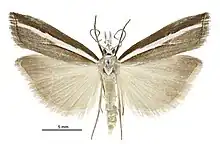Orocrambus vittellus
Orocrambus vittellus is a moth in the family Crambidae.[1] It was described by Henry Doubleday in 1843. [2][3] It is endemic to New Zealand.[4] This species has been recorded in the North and South Islands, as well as Stewart Island. It prefers a habitat that consists of grasslands.[5]
| Orocrambus vittellus | |
|---|---|
 | |
| Female | |
 | |
| Male | |
| Scientific classification | |
| Domain: | Eukaryota |
| Kingdom: | Animalia |
| Phylum: | Arthropoda |
| Class: | Insecta |
| Order: | Lepidoptera |
| Family: | Crambidae |
| Subfamily: | Crambinae |
| Tribe: | Crambini |
| Genus: | Orocrambus |
| Species: | O. vittellus |
| Binomial name | |
| Orocrambus vittellus (Doubleday in White and Doubleday, 1843) | |
| Synonyms | |
| |
The wingspan is 19–28 mm. Adults have been recorded on wing from November to April.[5]
The larvae feed on Agrostis tenuis and probably other grasses.[6]
References
Wikimedia Commons has media related to Orocrambus vittellus.
- Gordon, Dennis P., ed. (2010). New Zealand inventory of biodiversity: Kingdom animalia : chaetognatha, ecdysozoa, ichnofossils. Vol. 2. p. 457. ISBN 978-1-877257-93-3. OCLC 973607714. OL 25288394M. Wikidata Q45922947.
- Dieffenbach, E. (1843). "List of Annulose Animals hitherto recorded as found in New Zealand with descriptions of some new species by Messrs. Adam White and Edward Doubleday.". Travels in New Zealand: with contributions to the geography, geology, botany and natural history of the country. Vol. 2. London: John Murray. p. 285.
- Nuss, M.; et al. (2003–2017). "GlobIZ search". Global Information System on Pyraloidea. Retrieved December 12, 2017.
- "Orocrambus vittellus (Doubleday, 1843)". www.nzor.org.nz. Landcare Research New Zealand Ltd. Retrieved 2018-01-22.
- Gaskin, D. E. (1975). "Revision of the New Zealand Crambini (Lepidoptera: Pyralidae: Crambinae)". New Zealand Journal of Zoology. 2 (3): 265–363. doi:10.1080/03014223.1975.9517878.
- Gaskin, D. E. (1975). "Information on the life cycles of some New Zealand Crambini (Lepidoptera: Pyralidae:Crambinae)". New Zealand Journal of Zoology. 2 (3): 365–376. doi:10.1080/03014223.1975.9517879.
This article is issued from Wikipedia. The text is licensed under Creative Commons - Attribution - Sharealike. Additional terms may apply for the media files.